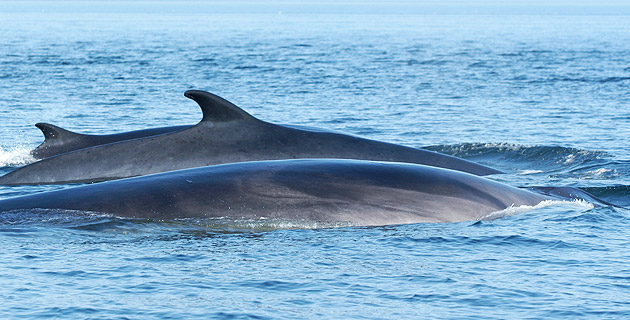Fin whales in the northern Gulf of St. Lawrence are in decline, according to a new study published in the periodical Ecology and Evolution. The population is believed to have contracted from 335 individuals (2004-2010) to 291 individuals (2010-2016). The decrease in the apparent survival rate, which corresponds to the combination of mortality and emigration, has also been more pronounced since 2012. These changes are worrisome for the fin whale, which is designated “Special Concern” under Canada’s Species at Risk Act.
Using photo archives to tally fin whales
To estimate the abundance of fin whales, researchers carried out a capture-mark-recapture technique using photo-identification. This is a statistical method that consists of “marking” individuals observed by photographing them and, during a subsequent observation, counting the marked individuals. A calculation is then used to estimate the actual number of fin whales. Analysis of photo-identification data compiled since 1982 in the northern Gulf of St. Lawrence by the Mingan Island Cetacean Study (MICS) has provided a portrait of how the population is evolving.
The results of this method may be biased if the population under study is not “closed”, meaning individuals are able to leave the population, as is the case for fin whales. To avoid such bias, researchers included another statistical analysis that differentiated regular whales (i.e. those seen practically every summer) from occasional visitors, thereby limiting the risk of inaccurately estimating the population size.
Frequent accidents
The reasons for the decline have not yet been confirmed, but it is likely that human activities are involved. Fin whales are the species most frequently involved in collisions with ships, and these accidents can be fatal. They are also prone to getting entangled in fishing gear. Additionally, fin whale mortality events are probably underestimated since, unlike right whales, their carcass does not necessarily float to the surface. Researchers therefore do not have access to all carcasses, which limits their ability to study the causes of mortality.
A changing ecosystem
Globally, the status of fin whales is improving (article in French), according to the most recent estimates from the International Union for the Conservation of Nature. However, on the scale of the northern Gulf of St. Lawrence, environmental changes may be working against the population. Ice is retreating earlier in late winter and water temperatures are rising. These changes may be impacting food availability in the area and encouraging them to change their feeding grounds, which might explain the decreasing number of individuals visiting the waters around the Mingan Archipelago. This hypothesis will have to be further studied since it is uncertain whether or not food abundance is actually declining. Moreover, if indeed fin whales have shifted their range, we should be able to observe them in other sectors. This is not currently the case, though there are several parts of the St. Lawrence that are not studied to determine the presence of fin whales.
“With climate change, overlaps between boat trajectories and whales may change,” explains Christian Ramp, co-author of the study and research coordinator at the Mingan Island Cetacean Study (MICS). Research must therefore continue to ensure that potential protection measures are genuinely adapted to the feeding grounds used by fin whales. For example, to reduce the risk of collisions, speed reductions could be imposed, similar to what has been done for right whales.
Source
- (2019) Schleimer, A., C. Ramp, J. Delarue, A. Carpentier, M. Bérubé, P. J. Palsbøll, R. Sears et P. S. Hammond. Decline in abundance and apparent survival rates of fin whales (Balaenoptera physalus) in the northern Gulf of St. Lawrence. Wiley Ecology and Evolution 2019: 1-14





